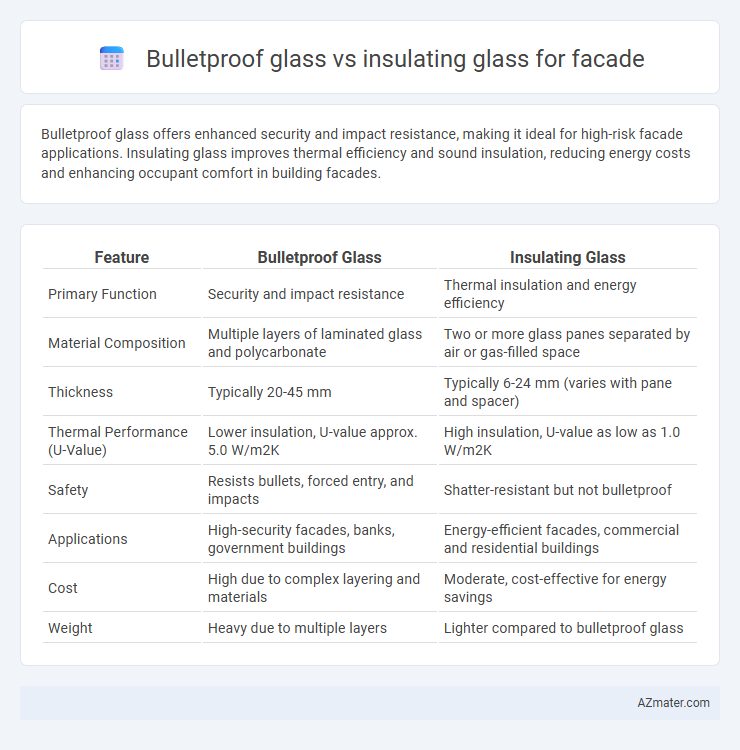Bulletproof glass offers enhanced security and impact resistance, making it ideal for high-risk facade applications. Insulating glass improves thermal efficiency and sound insulation, reducing energy costs and enhancing occupant comfort in building facades.
Table of Comparison
| Feature | Bulletproof Glass | Insulating Glass |
|---|---|---|
| Primary Function | Security and impact resistance | Thermal insulation and energy efficiency |
| Material Composition | Multiple layers of laminated glass and polycarbonate | Two or more glass panes separated by air or gas-filled space |
| Thickness | Typically 20-45 mm | Typically 6-24 mm (varies with pane and spacer) |
| Thermal Performance (U-Value) | Lower insulation, U-value approx. 5.0 W/m2K | High insulation, U-value as low as 1.0 W/m2K |
| Safety | Resists bullets, forced entry, and impacts | Shatter-resistant but not bulletproof |
| Applications | High-security facades, banks, government buildings | Energy-efficient facades, commercial and residential buildings |
| Cost | High due to complex layering and materials | Moderate, cost-effective for energy savings |
| Weight | Heavy due to multiple layers | Lighter compared to bulletproof glass |
Introduction: Comparing Bulletproof Glass and Insulating Glass
Bulletproof glass, designed with multiple layers of laminated glass and polycarbonate, offers superior impact resistance and security for building facades, effectively protecting against ballistic threats. Insulating glass, composed of two or more glass panes separated by a gas-filled space, primarily enhances thermal performance and energy efficiency while reducing noise transmission. Choosing between bulletproof and insulating glass depends on prioritizing security needs or energy-saving benefits in facade applications.
Defining Bulletproof Glass: Structure and Function
Bulletproof glass consists of multiple laminated layers of polycarbonate and glass, engineered to absorb and disperse the energy from high-velocity impacts, providing enhanced security and protection in facades. Its structure typically includes a combination of rigid glass and flexible plastic interlayers, which prevent penetration and reduce shattering. Unlike insulating glass, which primarily improves thermal performance, bulletproof glass focuses on resistance against ballistic threats while maintaining transparency for architectural applications.
Understanding Insulating Glass: Components and Benefits
Insulating glass consists of two or more glass panes separated by a sealed air or gas-filled space, enhancing thermal performance and energy efficiency for building facades. The components typically include low-emissivity coatings, spacer bars, and inert gases like argon or krypton, which reduce heat transfer and condensation. These features make insulating glass ideal for maintaining indoor comfort, lowering energy costs, and improving sound insulation in modern architectural designs.
Security Performance: Bulletproof vs Insulating Glass
Bulletproof glass offers superior security performance for facades by withstanding high-impact forces, such as bullets and violent attacks, due to its multi-layer laminated structure designed for ballistic resistance. Insulating glass enhances energy efficiency and thermal insulation but provides limited protection against forced entry or ballistic threats, making it less effective for security-critical applications. For facades requiring robust physical security, bulletproof glass remains the optimal choice, combining resilience against penetration with transparent design.
Thermal Insulation and Energy Efficiency Comparison
Bulletproof glass typically offers limited thermal insulation compared to insulating glass, which is engineered with multiple panes and gas fills to enhance energy efficiency in facades. Insulating glass reduces heat transfer significantly, lowering heating and cooling costs while maintaining natural light, whereas bulletproof glass prioritizes security over thermal performance. For building facades aiming at energy efficiency, insulating glass provides superior thermal insulation properties without compromising on safety when combined with laminated security layers.
Soundproofing Capabilities of Each Glass Type
Bulletproof glass combines multiple layers of glass and polycarbonate materials, providing moderate soundproofing by dampening impact noise, while primarily focusing on security and resistance to forced entry. Insulating glass, typically consisting of two or more glass panes separated by an air or gas-filled space, excels in soundproofing by significantly reducing external noise transmission and improving thermal insulation. For facade applications requiring superior acoustic performance, insulating glass offers more effective soundproofing compared to bulletproof glass.
Aesthetics and Design Flexibility for Façades
Bulletproof glass offers enhanced security while maintaining a sleek, transparent appearance that supports modern facade aesthetics without bulky frames. Insulating glass enhances energy efficiency through multi-pane constructions with low-emissivity coatings, allowing for versatile design options like tinted or reflective surfaces that improve building comfort and visual appeal. Architects balance bulletproof glass's minimalistic, robust style with insulating glass's customizable thermal performance to achieve facades that are both secure and visually dynamic.
Cost Considerations: Initial Investment and Maintenance
Bulletproof glass typically demands a higher initial investment than insulating glass due to its multi-layered composition and specialized materials designed for impact resistance. Maintenance costs for bulletproof glass can also be elevated, as repairs often require expert handling and replacement of complex laminated layers. Insulating glass, while more cost-effective upfront and easier to maintain, focuses primarily on thermal efficiency rather than security, making it a budget-friendly choice for energy savings but less protective against forced entry.
Environmental Impact and Sustainability Factors
Bulletproof glass typically requires more energy-intensive manufacturing processes and incorporates materials such as polycarbonate layers, which can pose recycling challenges and increase its environmental footprint compared to insulating glass. In contrast, insulating glass enhances energy efficiency by improving thermal insulation, thereby reducing heating and cooling demands and contributing to lower carbon emissions over a building's lifecycle. The sustainability advantages of insulating glass for facades lie in its ability to optimize energy consumption and support green building certifications, while bulletproof glass prioritizes security often at the expense of environmental performance.
Choosing the Right Glass Solution for Your Façade
Bulletproof glass offers superior security and impact resistance, making it ideal for high-risk areas requiring protection against forced entry or ballistic threats. Insulating glass enhances energy efficiency and thermal comfort by reducing heat transfer and improving sound insulation, suitable for climate control and noise reduction in commercial and residential facades. Selecting the right glass solution depends on prioritizing security needs versus energy performance, balancing safety requirements with environmental sustainability for optimal facade functionality.

Infographic: Bulletproof glass vs Insulating glass for Façade
 azmater.com
azmater.com